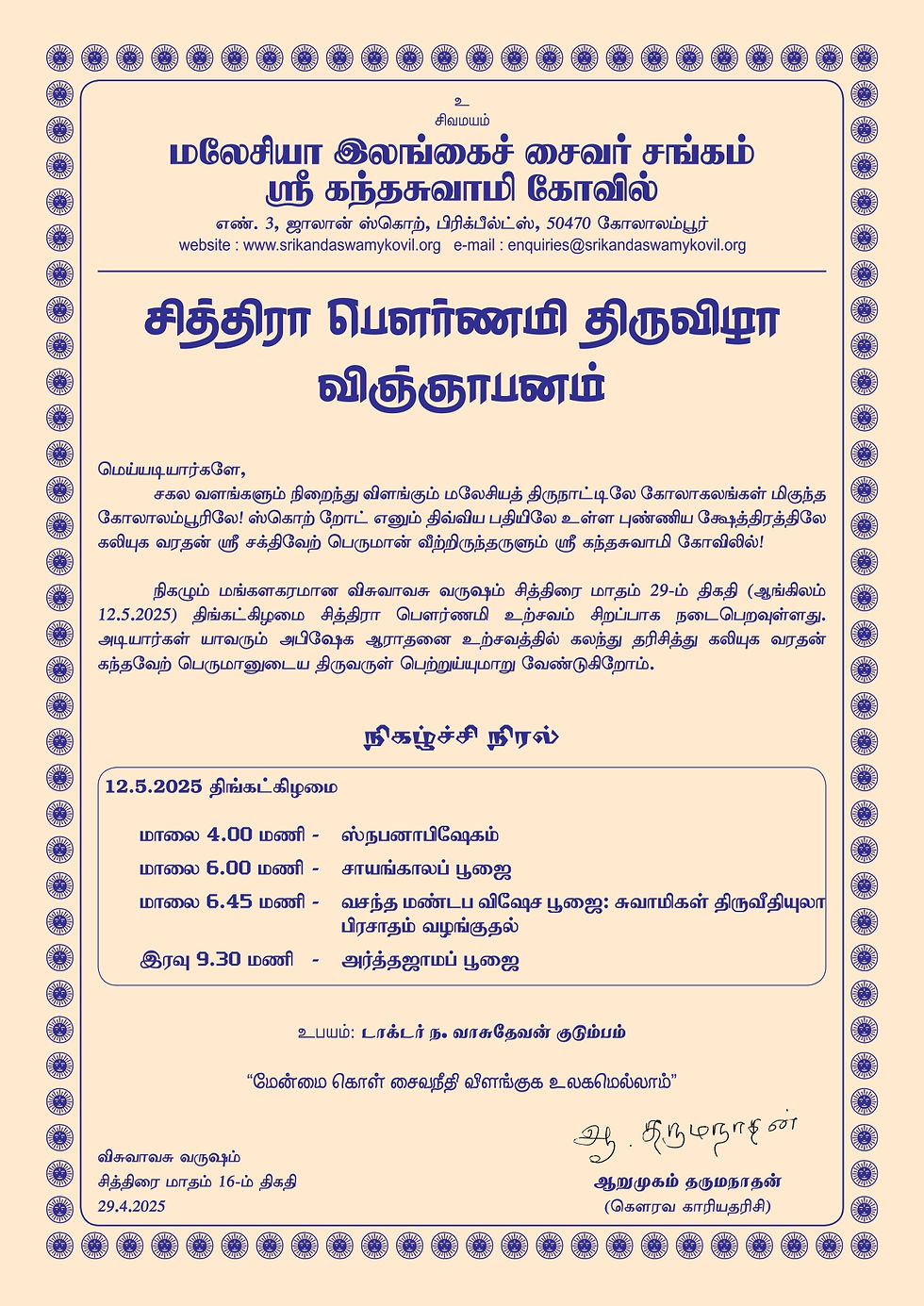Article: Chitthiraa Paurnami
- Sri Kandaswamy Temple Social Media
- May 11
- 4 min read

Photo by Ganapathy Kumar on Unsplash
Chitthiraa Paurnamai has more than one attribute to it
Chitthiraa paurnami for the new Tamil Year, Visuvaavasu, occurs on Monday 12th May 2025. This day has about three attributes (there may be more) to it. It is an auspicious day to have special prayers for Devi; this is also known as Chitthirakuptha viradham; people observe fast for their deceased mothers on this day.
The fact that full moon days are auspicious for Devi is quite apparent. In Astrology, one’s father’s attributes are predicted on the basis of the sun, and that of the mother on the basis of the moon. The presiding deity for the sun is Lord Siva, while that of the moon is Devi Uma. It is generally a known fact that the New Moon Day is said to be very apt to perform our rites of gratitude to our deceased fathers by offering them sesame along with water; this rite can be performed elaborately by offering other things like rice and vegetables. Likewise, the Full Moon Day is observed for the deceased mother. Chitthirakupthan is said to be the one who keeps an exhaustive record of the good and bad deeds of all the souls and presents it to Lord Yama when our souls are taken to Yama’s world. The constellation of Chitthirai in the month of Chitthirai is said to be Chittirakupthan’s birthday. People observe fast and pray to him on this day so that the effect of their karma will be considerably reduced.
Chitthiraa Paurnamai as a Day of Fast for One’s Deceased Mother
Our concern here is the third fact about the full moon day of the month of Chitthirai. There are people who observe the Chitthiraa Paurnami fast for their deceased mothers.
The normal way of observing this full moon day fast for one’s deceased mother is as follows: We have to get the utensils, which are exclusively reserved for cooking vegetarian dishes, have to be cleaned; the kitchen and the stove has to be cleaned. The house is mopped. We are aware that we have to have a head bath before starting any work related to the cooking of the food. As we will be offering the food to the soul of the deceased mother by placing the food in front of her photo, we are not supposed to taste it. We are also aware that milk, sweet rice, vadai and ‘paayasam’ form part of the spread of the meal. We observe fast for the day.
Once the meal is ready, we prepare the place, where we will be placing the photo of the deceased mother. After placing the photo, we make sure that the theebam, thoobakkaal, water, incense (oodhupatthi) and the holder for the incense are brought to the particular place. We adorn the picture with garlands and/or flowers. The food, which has been served on the tip portion of the banana leaf (thalai vaazhai ilai), is placed on a tray, which in turn is placed in front of the picture; the food will be covered with the tip portion of the banana leaf. The sweet rice, milk, ‘vadai’, ‘paayasam’ are also placed along with the meal. We do the prayers in the usual way; reciting of ‘panja puraanm’ is encouraged. Once the prayer is over, we shall wait for the camphor to become extinguished naturally. After this, we can proceed to enjoy our ‘banana leaf meal’; but before starting to enjoy the meal, remember to make a rice ball with all the curries included and keep on one side of the leaf. After eating, the rice ball is left out for the birds/animals to eat. It is ideal to feed the rice ball to a crow, which is considered to be the representative of Yama. There are people who will feed a crow first before they eat. After lunch, we continue our fast and have a light meal at night; if there is a real need, just a cup of tea may be taken in the evening.
What is said in the paragraph above is how most of our Saivites observe the fast for their deceased mother; but there are people who offer sesame seeds along with water (ellutthanneer tharppanam) to their deceased mother.
A Point for Our Contemplation
Before we wind up, I would like to share with everybody a small clarification as regards the offering of sesame and water. The website https://www.dinamani.com/religion/religion-news/2019/apr/04/amavasya-never-do-these-3127053.html mentions that certain thithis are auspicious for certain deities and continues to give the pairs as follows: Shadhurtthi – Lord Vinaayahar; Sashti – Lord Muruhan; Ehaathasi – Mahaa Vishnu; Ashtami – Bairavar; Sadhurtthasi – Lord Siva; Paurnami – Amman; after giving these pairs, it proceeds to say that likewise there is a thithi for the manes, and that is amaavaasai.
In his article, “Paurnami – Amaavaasai”, on page 9 of the book, ‘Saiva Viradhanggalum Vizhaakkalum’, Sri P. Sivananda Sarma says that the Sasthras generally mention ‘Amaavaasai’ as being auspicious to the manes (although ‘pithir’ popularly refers to forefathers, in this context it means the souls of the deceased, in general); considering ‘Paurnami’ to be auspicious for the deceased has become a customary norm among people.
From the two citations above, it is clear that Amaavaasai is the ideal thithi for the ‘ellu thanneer tharppanam’ to the deceased. The ‘ellu thanneer tharppanam’ done on ‘amaavaasai’ benefits all the deceased (father as well as mother) in general. This implies that it suffices to observe fast at home in the way mentioned above for the deceased mother.
Prepared by Dr. K. Thilagawathi

